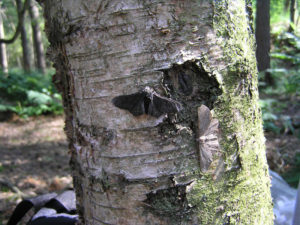 Hosts: Nels Elde and Vincent Racaniello
Hosts: Nels Elde and Vincent Racaniello
Nels and Vincent review experiments showing that the replacement of a pale moth with a black one during the industrial revolution was caused by a transposable element.
Click arrow to play
Download TWiEVO 10 (70 MB .mp3, 95 min)
Subscribe (free): iTunes, RSS, email
Links for this episode
- Last experiment of Michael Majerus (Biol Lett)
- Moth melanism mutation is transposon (Nature)
- Image credit
- Letters read on TWiEVO 10
This episode is sponsored by CuriosityStream, a subscription streaming service that offers over 1,400 documentaries and nonfiction series from the world’s best filmmakers. Get unlimited access starting at just $2.99 a month, and for our audience, the first two months are completely free if you sign up at curiositystream.com/microbe and use the promo code MICROBE.
Science Picks
Nels – Is Pokémon Go good for science? (one, two, three)
Vincent – Seven Brief Lessons on Physics by Carlo Rovelli
Music on TWiEVO is performed by Trampled by Turtles
Send your evolution questions and comments to [email protected]
Become a patron of TWiEVO




Just like Neal I want to have a camera to capture the critters that visit my garden. I do edible gardening, so I have had issues with rodents, squirrels, birds and raccoons. But this summer I have had some real mysterious issues.
I planted pink popcorn, and when the seedlings got to about three inches tall they were either dug up or chewed at the soil line and died. I put more seedlings out (I had started them indoors) and surrounded the area with hot chili flakes… and the next day they were cut down. I am assuming it was a bird. But I cannot be sure. So being a very stubborn person (something that is a prerequisite for gardening, after the fourth planting I got some pipes, netting, yarn and with large needle literally sewed a barrier about the baby popcorn. We’ll see what happens… it is now a foot tall, I’ll remove the barrier when it is two feet tall and see what happens.
I have successfully grown small popcorn before, even just last year. It is mostly for fun… and fun when you can take a small three to five inch cured ear of popcorn (another smaller variety is “Tom Thumb”), put it into a paper bag, then into a microwave and pop it! This is the first year I have had a critter target this particular plant.
Then something happened to my pear tree. My urban garden’s front fence is four espaliered apple trees and one four-in-one pear. The pear is not “wired up”, but is pruned down to stay a manageable size. This is a size to help manage pear rust, which involves hand removing leaves with the yellow spots… a task made much easier while listening to podcasts. It is also pruned to not encroach on the grape trellis. This year I had a bumper crop of pears, and I was anticipating a fall and winter of Orcas, Bosc and Comice pears (the fourth one barely makes it).
But then we went on a two week trip to move youngest child with lots of stuff to a college town almost two thousand miles away. When we came back I was watering my wilting garden (thanks house-sitter!), when I noticed one pear on the lowest branch… and then noticed it was the only pear.
This is why I really want to see the wild life in my yard.
I noticed on our neighborhood social media that not only had coyote been seen in the natural area by our local university, but a buck deer! There were reports of it going up the street we live on. I am assuming that a young deer ate my deer. Or it could have been raccoons. Or a bipedal who did not know the pears would not be ready for a month.
My apples were not touched. But they are covered in the nylon socks used in shoe stores to try on shoes, it discourages apple maggot flies (seriously! it was discovered by tree fruit gardeners in Oregon, and they are sold in local nurseries — it is something that can be done only by a small home gardener, since it takes lots of time). Perhaps they also discourage deer.
Oh, and all of the tall sunflowers were decapitated. Fortunately this has encouraged side flowers to emerge, so I will have more sunflowers. Thanks deer!